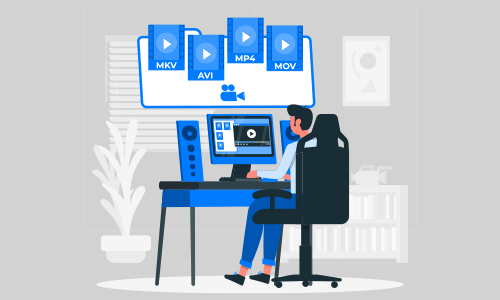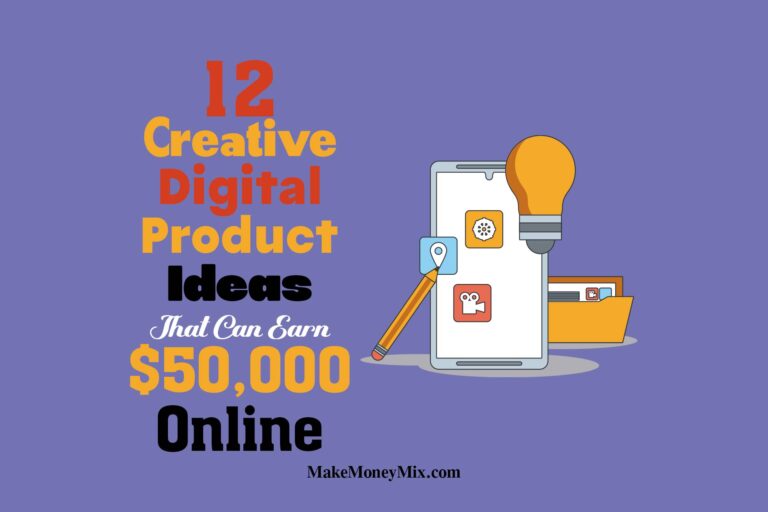6 Online Business Ideas You Can Start With $0

We all know that starting any business requires investment. But can you imagine there are some small online businesses you can start without a dime?
You’re not alone if you are looking for ways to make money online but lack the capital to invest.
Many people seek free, practical business ideas that generate significant income.
In this post, I’ll explore six online business ideas that earn people over $14,000 monthly.
Even better, these ideas can be started today using free tools, websites, and apps.
Let’s dive in!
6 Creative Online Business Ideas with Zero Investment
In 2025, starting an online business is easy. You can launch your store within a day.
Here, I am sharing some innovative small business ideas online. All you need is a few online tools and platforms to start.
Let’s check out what these businesses are and how you can start. I will show you step-by-step instructions with tips for success.
This information will help you make informed decisions, and you can start right away.
1. Pick-One Videos
“Pick-one” videos are an exciting and lucrative way to generate income online.
These simple yet engaging videos allow viewers to choose their favorite image or video from a series, making them highly shareable and perfect for platforms like YouTube Shorts and TikTok.
Below, we’ll break down the process of creating these videos, offer practical tools, and share tips for maximizing your success.
How to Start
Step 1: Understand the Appeal
The success of pick-one videos lies in their simplicity and interactivity. They encourage viewers to:
- Engage with the content by making choices.
- Share the video with friends to compare picks.
- Watch repeatedly, which boosts algorithmic performance.
For example, a YouTube channel, ImagineFantasy used AI-generated pick-on video that got over 27.9 million views in one month.
If it gets an average of $0.15 RPM per 1K view, it earns over $4,000 monthly.
Step 2: Gather Content
To create a pick-one video, you’ll need compelling visuals. Here are two main approaches:
Option A: Use Stock Videos
- Visit free stock video websites like Pixabay or Pexels.
- Search for interesting clips that fit your theme (e.g., nature, animals, or abstract visuals).
- Download royalty-free content for free use.
Option B: Generate AI Images
- Use tools like Microsoft Designer, which leverages DALL-E 3 technology to create high-quality images.
- Experiment with unique prompts to generate eye-catching visuals (e.g., “futuristic cityscapes” or “whimsical animals”).
- Microsoft Designer currently offers unlimited image generation for free.
Step 3: Edit Your Video
Editing is where your content comes to life. Use free tools like CapCut, which offers:
- AI-powered features such as auto-captions and special effects.
- Easy-to-use templates for quick assembly.
- The ability to add music or sound effects to enhance engagement.
Editing Tips:
- Keep your videos short (15–30 seconds) to maximize completion rates.
- Add captions or prompts like “Pick your favorite!” to encourage interaction.
- Use transitions between clips/images to maintain viewer interest.
Step 4: Publish on the Right Platforms
Focus on platforms that prioritize short-form content:
- YouTube Shorts: With over 2 billion logged-in users monthly, YouTube Shorts is a goldmine for exposure. Creators earn approximately $0.10–$0.20 per 1,000 views through ad revenue.
- TikTok: TikTok’s Creator Rewards program can be even more lucrative. Viral videos often earn thousands of dollars as rewards.
Optimization Tips:
- Use trending hashtags and keywords in your video descriptions (e.g., #PickOneChallenge).
- Post consistently to build momentum and train algorithms to promote your content.
Step 5: Monetize Your Videos
Once your videos start gaining traction, monetize them through:
- Ad Revenue: Join YouTube’s Partner Program or TikTok’s monetization initiatives.
- Affiliate Marketing: Add affiliate links related to your content theme in product descriptions.
- Brand Collaborations: Brands may approach you for sponsorship as your audience grows.
Tips for Success
- Create a Strong Hook: Grab attention using bold visuals or intriguing captions within the first few seconds.
- Leverage Trends: Incorporate trending topics or themes (e.g., AI-generated art or pop culture references) to increase shareability.
- Engage with Viewers: Reply to comments and encourage users to share their picks in the comments section.
- Experiment with Formats: Test different themes (e.g., “Which vacation spot would you pick?”) to see what resonates most with your audience.
Read More: 77 Easy Small Business Ideas You Can Start This Year
2. Print-On-Demand Stores
Print-on-demand (POD) is one of the most beginner-friendly e-commerce business models you can start today without any upfront investment.
It allows you to sell custom-designed products like T-shirts, mugs, hoodies, and more without worrying about inventory or shipping.
In this guide, we’ll break down how to launch your POD store using free tools and platforms, along with practical tips to ensure success.
What Is Print-On-Demand?
Print-on-demand is a business model where products are only created after a customer orders. This means:
- No upfront costs for inventory.
- There is no need to manage storage or shipping.
- You can focus on creating designs and marketing your store.
For example:
- A blank T-shirt costs $10 from a POD supplier.
- You sell it for $25 on your online store.
- When a customer buys it, the supplier prints your design, ships the product directly to the buyer, and you keep the $15 profit (minus platform fees).
How to Start
Step 1: Choose a Free Platform to Launch Your Store
To start a print-on-demand business for free, you need an online store.
One of the best platforms for beginners is Fourthwall, which integrates seamlessly with Printful (a leading POD supplier).
Why Fourthwall?
- It’s completely free to set up your company, as successful creators and YouTubers like Philip DeFranco use.
- It handles all payments and integrates with POD suppliers.
How to Get Started:
- Visit Fourthwall’s website and sign up for a free account.
- Follow their step-by-step process to set up your store.
- Browse their catalog of blank products (e.g., T-shirts, mugs, hoodies) and select items you want to sell.
Step 2: Create Custom Designs
The heart of a print-on-demand business is your designs. Whether you’re creating funny memes, inspirational quotes, or artistic graphics, your designs will determine your success.
Free Tools for Creating Designs:
- Photopea: A free Photoshop alternative that allows you to create high-quality designs from scratch or edit existing images.
- Canva Free: Offers pre-built templates for T-shirts, mugs, and more. You can easily customize these templates with text, images, or graphics.
Pro Tip: If you’re new to design:
- Start with typography-based designs (e.g., funny quotes or motivational phrases).
- Use Canva’s free clip art library for simple but effective graphics.
Step 3: Add Products to Your Store
Once you’ve created your designs:
- Upload them onto the blank products in Fourthwall.
- Set prices for each item. Aim for a healthy profit margin while staying competitive.
- Write compelling product descriptions highlighting the design’s appeal (e.g., “Perfect gift for coffee lovers!”).
Step 4: Promote Your Store
Now that your store is live, it’s time to drive traffic and attract customers.
The best way to do this for free is through content creation on social media platforms like TikTok and Pinterest.
TikTok Marketing Tips:
- Create short videos showcasing your products in fun or relatable scenarios.
- Use trending sounds and hashtags to increase visibility (e.g., #FunnyTShirts or #GiftIdeas).
- Consistently posting viral videos can bring thousands of visitors to your store.
Pinterest Marketing Tips:
- Turn your product images into pins using Canva’s free Pinterest templates.
- Optimize your pins with keywords like “funny mugs” or “cute hoodie gifts.”
- Link each pin directly to your product page.
Example: A TikTok creator posted a video of their meme T-shirt design with the caption “When Lincoln Park lyrics hit too hard,” which went viral with over 2.8 million views—driving massive sales.
Step 5: Scale Your Business
Once you’ve made some initial sales, consider scaling up by expanding your product line or investing in additional sales channels like Etsy.
Why Etsy?
Etsy is one of the largest online marketplaces for unique handmade items, making it perfect for print-on-demand products.
With millions of monthly visitors, Etsy can help you reach customers looking for creative gifts.
How to Get Started on Etsy:
- Open an Etsy shop (requires a small listing fee of $0.20 per item).
- List your POD products from Fourthwall or Printful on Etsy.
- Use Etsy SEO strategies (e.g., adding relevant keywords in titles and tags) to make your listings discoverable.
Tips for Success in Print-On-Demand
- Focus on Niche Designs: Target specific audiences (e.g., dog lovers, gamers, coffee enthusiasts) with tailored designs.
- Test Multiple Platforms: Start with Fourthwall but expand to platforms like Etsy or Redbubble as you grow.
- Leverage Free Traffic: If used effectively, social media platforms like TikTok and Pinterest are goldmines for organic traffic.
- Stay Consistent: Post new designs regularly and experiment with different styles or themes.
- Monitor Trends: Keep an eye on trending topics or memes that you can incorporate into your designs.
Common Challenges and How to Overcome Them
- Low Sales Initially: Building momentum takes time.
- Solution: Create viral content on TikTok or Pinterest to drive traffic.
- High Competition: The POD market is crowded.
- Solution: Differentiate yourself by targeting underserved niches or offering unique designs.
- Shipping Times: Since POD items are made-to-order, delivery can take longer than traditional e-commerce.
- Solution: Communicate shipping times on product pages to manage customer expectations.
3. Tutorial Affiliate Marketing
Tutorial affiliate marketing is a powerful online business model combining content creation and affiliate marketing.
Creating helpful tutorials for apps, websites, or tools allows you to earn commissions whenever viewers sign up for the recommended products.
This business is easy to start, requires no upfront investment, and can generate passive income over time.
In this guide, we’ll walk you through starting your own tutorial affiliate marketing business and share tips for success.
What Is Tutorial Affiliate Marketing?
Tutorial affiliate marketing involves creating “how-to” videos or articles that teach people how to use a product or service.
You include an affiliate link (a referral link) in the description or article, and when someone clicks on it and purchases the product or subscribes, you earn a commission.
For example:
- A YouTube tutorial on how to design T-shirts using Canva includes an affiliate link to Canva Pro.
- Viewers who click the link and sign up for Canva Pro generate commissions for the creator.
This business model is evergreen because people search for tutorials on popular apps and tools.
How to Start
Step 1: Choose Your Niche
Start by selecting a niche that aligns with your interests or expertise. Popular niches include:
- Graphic design tools (e.g., Canva, Photoshop)
- Productivity apps (e.g., Notion, Trello)
- E-commerce platforms (e.g., Shopify, Etsy)
- Tech gadgets or software
Tips for Choosing a Niche:
- Pick a niche with high demand for tutorials (use Google Trends to research).
- Focus on tools or apps with affiliate programs that pay well.
- Choose something you’re comfortable explaining to others.
Step 2: Sign Up for Affiliate Programs
You need access to affiliate links for the products you want to promote to earn commissions. Here’s how to get started:
Affiliate Directories:
- Impact: One of the largest directories with brands offering affiliate links.
- Amazon Associates: Perfect for promoting physical products like tech gadgets.
- ShareASale: Offers programs for various industries.
How to Sign Up:
- Visit the affiliate directory website.
- Create a free account.
- Apply for programs related to your niche (e.g., Canva Pro).
Once approved, you’ll receive unique affiliate links to track clicks and conversions.
Step 3: Create Tutorials
The core of your business is creating high-quality tutorials that provide value to viewers.
Tutorials can be in video format (YouTube or TikTok) or written format (blogs).
Video Tutorials:
- Use free screen recording tools like CapCut (which includes an inbuilt screen recorder).
- Record yourself using the app or tool while explaining its features.
- Edit your video using CapCut’s free AI features like auto-captions and special effects.
Written Tutorials:
- Write step-by-step guides explaining how to use the tool.
- Use AI writing assistants like ChatGPT to draft or edit your content.
- Post your tutorial on free blogging platforms like Medium.
Step 4: Optimize Your Content
Optimize your tutorials for search engines and social media algorithms to maximize views and clicks.
YouTube SEO Tips:
- Create keyword-rich titles (e.g., “How to Design T-Shirts Using Canva – Beginner’s Guide”).
- Add detailed descriptions with relevant keywords and your affiliate link.
- Use eye-catching thumbnails to attract clicks.
TikTok Optimization Tips:
- Use trending hashtags related to your niche (#CanvaTutorials, #AffiliateMarketing).
- Keep videos short and engaging (15–60 seconds).
- Add captions using CapCut’s auto-caption feature for accessibility.
Step 5: Promote Your Content
Once your tutorial is live, promote it across multiple platforms to drive traffic.
Platforms to Use:
- YouTube: Ideal for evergreen content that ranks in search results over time.
- TikTok: Great for quick exposure and viral potential.
- Pinterest: Create pins linking to your tutorial blog posts or YouTube videos.
Cross-Promotion Tips:
- Share links on social media accounts (Instagram Stories, Twitter posts).
- Collaborate with influencers in your niche for mutual promotion.
Step 6: Track Your Earnings
Monitor clicks, conversions, and commissions using analytics tools provided by affiliate programs.
This will help you understand which tutorials perform best and refine your strategy.
Tips for Success in Tutorial Affiliate Marketing
- Create Evergreen Content: Focus on topics that remain relevant over time (e.g., “How to Use Canva” instead of “Canva’s Latest Update”).
- Be Authentic: Only promote products you genuinely believe in. This builds trust with your audience.
- Engage Viewers: Reply to comments on YouTube or TikTok and encourage viewers to ask questions about the product/tool.
- Experiment with Formats: Try different styles of tutorials such as screen recordings, narrated slideshows, or live demonstrations.
- Leverage Free Tools: Use CapCut for editing, Adobe Podcast Enhance Speech AI for professional voiceovers, and ChatGPT for writing assistance.
Common Challenges & Solutions
- Low Traffic Initially: Building an audience takes time.
- Solution: Post consistently and optimize content for SEO and social media algorithms.
- Low Conversion Rates: Not everyone who clicks will purchase/sign up.
- Solution: Highlight the benefits of the product/service clearly in your tutorial.
- Finding Affiliate Programs: Some programs may reject applications if you’re new.
- Solution: Start with beginner-friendly programs like Amazon Associates or Canva Pro.
4. Pinterest Blogging
Pinterest blogging is an excellent online business model that combines the power of visual content with affiliate marketing.
Creating visually appealing pins that link back to blog posts can drive traffic to affiliate products and earn commissions.
The best part?
You can start this business for free using tools and platforms that require no upfront investment.
In this guide, we’ll explore how to launch a Pinterest blogging business and practical tips and strategies for success.
What Is Pinterest Blogging?
Pinterest blogging involves creating pins on Pinterest that link to blog posts containing affiliate links.
When users click on your pins, they’re directed to your blog, where they can learn more about the topic and potentially purchase products through your affiliate links.
Each sale generates a commission for you.
- For example, “Bathroom Storage Ideas for Small Spacpin es” leads users to a blog post with Amazon affiliate links for storage products.
- You earn a commission when users click on the links and buy the products.
This business model works because Pinterest is a visual search engine, making it ideal for driving organic traffic to blogs.
How to Start
Step 1: Choose Your Niche
Start by selecting a niche that aligns with your interests or expertise. Popular niches include:
- Home organization (e.g., storage solutions, decor ideas)
- DIY crafts
- Fashion and beauty
- Fitness and wellness
- Recipes and meal planning
Tips for Choosing a Niche:
- Focus on highly searched topics on Pinterest (use Pinterest Trends or Google Trends to research).
- Choose a niche with products that have affiliate programs (e.g., Amazon Associates).
Step 2: Create Your Blog
To host your content, you need a blog. If you’re starting with no budget, use Medium, a free blogging platform that allows affiliate links within articles.
How to Set Up Your Blog on Medium:
- Visit Medium.com and sign up for a free account.
- Customize your profile with a professional bio and image.
- Start writing articles related to your niche.
Pro Tip: Use AI tools like ChatGPT or Google’s Gemini to help quickly draft or edit your blog posts.
Step 3: Sign Up for Affiliate Programs
Affiliate programs provide the links you’ll use in your blog posts. The most popular program for Pinterest bloggers is Amazon Associates, which is free to join.
How to Sign Up for Amazon Associates:
- Visit affiliate-program.amazon.com.
- Create a free account.
- Search for products related to your niche and generate affiliate links.
Affiliate directories like Impact or ShareASale can also be great options to promote non-Amazon products.
Step 4: Create Pins
Pins are the gateway to your blog posts—they must be visually appealing and optimized for Pinterest’s algorithm.
Free Tools for Creating Pins:
- Canva Free: Offers pre-built Pinterest templates you can customize with text, images, and graphics.
- Photopea: A free Photoshop alternative for advanced design edits.
Design Tips:
- Use bold fonts and vibrant colors to grab attention.
- Add text overlays that describe the pin’s value (e.g., “10 Storage Ideas for Small Bathrooms”).
- Include high-quality images related to your topic.
Step 5: Optimize Pins for SEO
Pinterest is a search engine, so optimizing your pins with keywords is essential for visibility.
SEO Tips:
- Use relevant keywords in pin titles (e.g., “Bathroom Organization Hacks”).
- Write detailed descriptions with keywords naturally integrated.
- Add hashtags like #HomeOrganization or #DIYStorageIdeas.
Step 6: Post Consistently
Consistency is key to growing your presence on Pinterest. Aim to post several pins per week, linking to different blog posts.
Scheduling Tools:
Use free tools like Tailwind’s trial version or Pinterest’s native scheduling feature to plan pins.
Step 7: Drive Traffic & Earn Commissions
As users click on your pins and visit your blog, they’ll interact with the affiliate links embedded in your articles.
Each purchase earns you a commission through programs like Amazon Associates.
Tips for Success in Pinterest Blogging
- Focus on High-Demand Topics: Research what’s trending on Pinterest using its Trends tool or Google Trends.
- Create High-Quality Content: Ensure your pins and blog posts provide value—users should feel inspired or informed after engaging with them.
- Leverage Free AI Tools: Use AI chatbots like ChatGPT or Copilot to write compelling blog posts quickly.
- Engage With Your Audience: Respond to comments on Medium articles or Pinterest pins to build trust.
- Experiment With Pin Styles: Test different designs (minimalist vs bold) to see what resonates most with your audience.
Common Challenges & Solutions
- Low Traffic Initially: Building an audience takes time.
- Solution: Focus on SEO optimization and posting consistently.
- Low Conversion Rates: Not all clicks result in sales.
- Solution: Write persuasive product descriptions in your blog posts highlighting benefits.
- Time Management: Creating pins and writing articles can be time-consuming.
- Solution: Create content in batches using tools like Canva and schedule posts beforehand.
5. Selling Digital Printables
Selling digital printables is a creative and rewarding online business that requires minimal upfront investment.
Printables are downloadable products like planners, labels, eBooks, or charts that customers can print at home.
You can start this business today with free tools and platforms available, even if you’re broke.
Here’s a detailed guide to launching your own digital printables business.
What Are Digital Printables?
Digital printables are files that customers purchase and download to print themselves. These products cater to various needs, such as:
- Organization (e.g., planners, calendars)
- Education (e.g., worksheets for homeschooling)
- Creativity (e.g., coloring pages, craft templates)
- Events (e.g., party invitations, wedding templates)
For example:
- A seller creates printable storage labels and charts for home organization.
- Customers download these files after purchase and use them immediately.
This business model is scalable because you only need to create the product once, but it can be sold repeatedly without additional effort.
How to Start
Step 1: Choose Your Niche
Start by identifying a niche that aligns with your interests and has high demand. Popular niches include:
- Budget trackers
- Meal planners
- Wedding templates
- Fitness logs
- Educational worksheets
Tips for Choosing a Niche:
- Research trending topics on Pinterest or Etsy.
- Focus on niches with evergreen appeal (e.g., planners).
- Look for gaps in the market where demand exceeds supply.
Step 2: Create Your Printables
The core of your business is designing high-quality printables that customers will find helpful or appealing.
Free Tools for Designing Printables:
- Canva Free: Offers pre-built templates for planners, labels, and more. You can customize fonts, colors, and graphics easily.
- Photopea: A free Photoshop alternative for advanced design needs.
- Visme: Another free tool with options for creating professional-looking designs.
Design Tips:
- Keep layouts clean and easy to use.
- Use high-resolution images to ensure quality when printed.
- Add customizable elements (e.g., editable text fields) to enhance usability.
Step 3: Choose a Selling Platform
Once your printables are ready, you need a platform to sell them. Several free options are available:
Top Platforms for Selling Printables:
Gumroad:
- Ideal for beginners.
- Allows you to list digital products for free.
- Popular among creators selling eBooks and templates.
Etsy:
- A well-established marketplace with millions of buyers.
- Offers tools like SEO optimization and advertising options.
- Requires a small listing fee ($0.20 per item).
Sellfy:
- Simplifies selling digital products without needing a website.
- Includes built-in email marketing tools.
Creative Market:
- Focuses on high-quality designs and attracts creative professionals.
- Best for premium-priced products.
Pro Tip: If you want more control over branding, consider setting up your website using platforms like Squarespace or Shopify.
Step 4: Create Listings
Your product listing is crucial for attracting customers and driving sales.
How to Optimize Listings:
- Upload high-resolution images or mockups showing how the printable will look (e.g., a planner filled out with sample text).
- Write detailed descriptions that highlight the product’s features and benefits.
- Use rich keywords in titles and tags to improve discoverability through search engines (e.g., “Printable Budget Tracker PDF”).
Step 5: Promote Your Printables
Marketing is key to driving traffic to your store and increasing sales.
Free Promotion Strategies:
- Pinterest: Create visually appealing pins linking to your store or product pages. Use Canva templates to design pins optimized for Pinterest SEO.
- Social Media: Share behind-the-scenes content or tutorials on Instagram Stories or TikTok showcasing how your printables can be used.
- Free Samples: Offer one free downloadable to attract customers and build trust.
- Email Marketing: Build an email list using tools like Mailchimp or Sellfy’s built-in feature to announce new products or promotions.
Step 6: Scale Your Business
Once you’ve gained traction, scale up by diversifying your product offerings or expanding into other platforms.
Ideas for Scaling:
- Add new categories of printables based on customer feedback (e.g., seasonal planners).
- Collaborate with influencers in your niche to promote your products.
- Invest in paid advertising on platforms like Etsy Ads or Pinterest Ads.
Tips for Success in Selling Digital Printables
- Focus on Quality: High-quality designs lead to better reviews and repeat customers.
- Research Trends: Stay updated on popular themes or styles in your niche (e.g., minimalist designs).
- Optimize SEO: Use keywords strategically in product titles, descriptions, and tags to rank higher in search results.
- Engage Customers: Respond promptly to inquiries and encourage reviews to build credibility.
- Experiment with Pricing: Start with competitive prices ($5–$10 per printable) but adjust based on demand and perceived value.
Common Challenges & Solutions
- Low Sales Initially: Building an audience takes time.
- Solution: Focus on SEO optimization and consistent social media promotion.
- Competition: The market for printables can be saturated in some niches.
- Solution: Target underserved niches or add unique features like editable fields.
- File Theft: Digital products are prone to unauthorized sharing.
- Solution: Add watermarks or lower preview resolution in mockup images.
6. Montage Videos
Montage videos are a creative and cost-effective way to produce engaging content for social media platforms like TikTok, YouTube Shorts, and Instagram Reels.
These videos combine multiple clips or images with voiceovers, music, or text to tell a story or share fun facts.
With free tools and platforms, starting a montage video business is accessible even if you’re broke. Here’s how you can get started.
What Are Montage Videos?
Montage videos are dynamic compilations of stock footage, images, or pre-recorded clips edited with transitions, music, or voiceovers.
Unlike static slideshows, montage videos are fast-paced and visually compelling, making them ideal for capturing attention on social media.
For example:
- A TikTok creator posted a montage video about chia seeds with fun facts and gained over 10 million views in just two months.
- Such videos can generate significant income through ad revenue or platform-specific monetization programs like TikTok Creator Rewards.
How to Start
Step 1: Choose Your Niche
Start by selecting a niche that resonates with your interests and has high engagement potential. Popular niches include:
- Fun facts (e.g., health tips, historical trivia)
- DIY guides (e.g., home improvement or crafts)
- Fitness transformations
- Travel highlights
- Trending topics (e.g., AI-generated visuals)
Tips for Choosing a Niche:
- Research trending topics on TikTok or YouTube Shorts.
- Focus on niches that allow you to create evergreen content (videos that stay relevant over time).
Step 2: Gather Content
You’ll need high-quality visuals to create your montage videos. Here’s how to source content for free:
Option A: Stock Footage
Use royalty-free stock footage sites like:
- Pixabay
- Pexels
Search for clips related to your topic (e.g., nature scenes, food preparation) and download them for free.
Option B: AI-Generated Images
Use tools like Microsoft Designer to create unique visuals using DALL-E 3 technology. Microsoft Designer currently offers unlimited free image generation.
Step 3: Write Your Script
Most montage videos include voiceovers or text overlays to guide viewers through the content. Use AI tools like ChatGPT to write engaging scripts quickly.
Script Tips:
- Keep it concise and engaging.
- Use storytelling techniques to maintain viewer interest.
- Include fun facts or actionable tips that encourage viewers to share the video.
Step 4: Edit Your Video
Editing is where your content comes together. Free video editing tools make this process simple.
Recommended Tools:
- CapCut:
- Offers AI-powered features like auto-captions and special effects.
- Includes free templates for transitions and overlays.
- Adobe Express Montage Maker:
- It allows you to easily trim, resize, animate elements, and add filters.
- Perfect for beginners with no prior editing experience.
Editing Tips:
- Use smooth transitions between clips to keep the video dynamic.
- Add upbeat, royalty-free music from platforms like CapCut’s library.
- Utilize CapCut’s auto-caption feature for professional-looking text overlays.
Step 5: Publish on Social Media Platforms
Focus on platforms that prioritize short-form video content:
Best Platforms:
TikTok:
- TikTok’s Creator Rewards Program pays creators based on views.
- Viral videos can earn $0.30–$1 RPM per 1,000 views.
YouTube Shorts:
- YouTube’s Partner Program monetizes Shorts with an average RPM of $0.10–$0.20 per 1,000 views.
Instagram Reels:
- It is ideal for brand collaborations and organic reach.
Optimization Tips:
- Use trending hashtags (#FunFacts #MontageVideo).
- Post consistently to build momentum.
- Create eye-catching thumbnails for YouTube Shorts.
Step 6: Monetize Your Videos
Montage videos can be monetized in several ways:
Ad Revenue:
Join YouTube’s Partner Program or TikTok Creator Rewards once you meet their eligibility requirements (e.g., minimum followers/views).
Affiliate Marketing:
Include affiliate links in your video descriptions for products related to your niche (e.g., health supplements for fitness montages).
Brand Collaborations:
Brands may approach your audience for sponsorship or product placements as your audience grows.
Tips for Success in Montage Video Creation
- Create Shareable Content: Focus on topics encouraging viewers to share the video with friends (e.g., “Which fun fact surprised you?”).
- Leverage Trends: Incorporate trending themes or challenges into your montages.
- Engage Viewers: Reply to comments and ask questions in captions to boost engagement.
- Experiment With Formats: Test different styles—voiceover-led montages vs text-only montages—to see what performs best.
- Stay Consistent: Post regularly to train algorithms to promote your content.
Common Challenges & Solutions
- Low Views Initially: Building an audience takes time.
- Solution: Optimize SEO with keywords and hashtags while posting consistently.
- Content Saturation: Many creators produce montage videos in popular niches.
- Solution: Find unique angles or underserved topics within your niche.
- Editing Time: Editing can be time-consuming.
- Solution: Use AI-powered tools like CapCut to streamline the process.
Final Thoughts
Starting an online business doesn’t have to cost money; instead, it just needs creativity and effort!
Whether you’re drawn to creating viral videos, selling custom products, or leveraging affiliate marketing, these seven ideas offer diverse opportunities for generating income online.
With so many free tools available today, there’s no better time to start!
Which idea will you try first?










